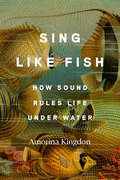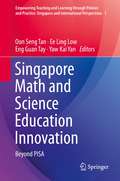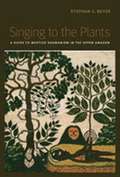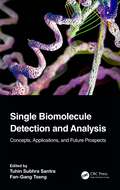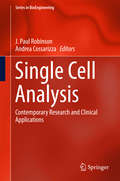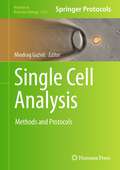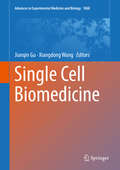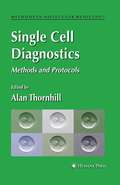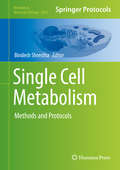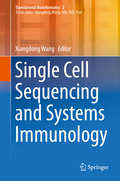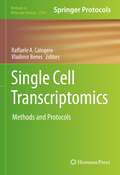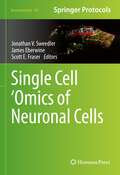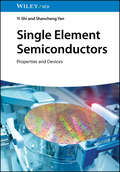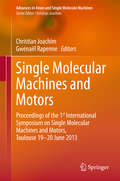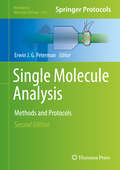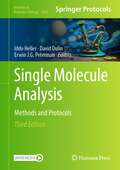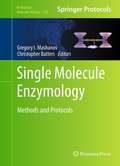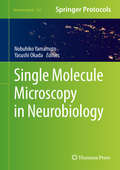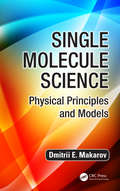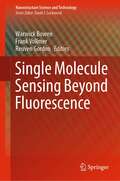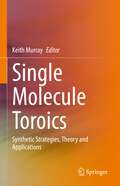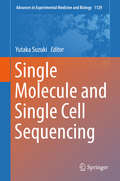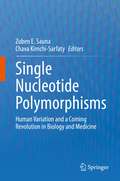- Table View
- List View
Sing Like Fish: How Sound Rules Life Under Water
by Amorina KingdonA captivating exploration of how underwater animals tap into sound to survive, and a clarion call for humans to address the ways we invade these critical soundscapes—from an award-winning science writer&“Sing Like Fish is that rare book that makes you see the world differently.&”—Mark Kurlansky, New York Times bestselling author of Salt and CodFor centuries, humans ignored sound in the &“silent world&” of the ocean, assuming that what we couldn&’t perceive, didn&’t exist. But we couldn&’t have been more wrong. Marine scientists now have the technology to record and study the complex interplay of the myriad sounds in the sea. Finally, we can trace how sounds travel with the currents, bounce from the seafloor and surface, bend with the temperature and even saltiness; how sounds help marine life survive; and how human noise can transform entire marine ecosystems. In Sing Like Fish, award-winning science journalist Amorina Kingdon synthesizes historical discoveries with the latest scientific research in a clear and compelling portrait of this sonic undersea world. From plainfin midshipman fish, whose swim-bladder drumming is loud enough to keep houseboat-dwellers awake, to the syntax of whalesong; from the deafening crackle of snapping shrimp, to the seismic resonance of underwater earthquakes and volcanoes; sound plays a vital role in feeding, mating, parenting, navigating, and warning—even in animals that we never suspected of acoustic ability. Meanwhile, we jump in our motorboats and cruise ships, oblivious to the impact below us. Our lifestyle is fueled by oil in growling tankers and furnished by goods that travel in massive container ships. Our seas echo with human-made sound, but we are just learning of the repercussions of anthropogenic noise on the marine world&’s delicate acoustic ecosystems—masking mating calls, chasing animals from their food, and even wounding creatures, from plankton to lobsters. With intimate and artful prose, Sing Like Fish tells a uniquely complete story of ocean animals&’ submerged sounds, envisions a quieter future, and offers a profound new understanding of the world below the surface.
Singapore Math and Science Education Innovation: Beyond PISA (Empowering Teaching and Learning through Policies and Practice: Singapore and International Perspectives #1)
by Ee Ling Low Oon Seng Tan Eng Guan Tay Yaw Kai YanThis edited volume explores key areas of interests in Singapore math and science education including issues on teacher education, pedagogy, curriculum, assessment, teaching practices, applied learning, ecology of learning, talent grooming, culture of science and math, vocational education and STEM. It presents to policymakers and educators a clear picture of the education scene in Singapore and insights into the role of math and science education in helping the country excel beyond international studies such as PISA, the pedagogical and curricula advancements in math and science learning, and the research and practices that give Singaporean students the competitive edge in facing the uncertain and challenging landscape of the future.
Singing To The Plants: A Guide To Mestizo Shamanism In The Upper Amazon
by Stephan V. BeyerIn the Upper Amazon, mestizos are the Spanish-speaking descendants of Hispanic colonizers and the indigenous peoples of the jungle. Some mestizos have migrated to Amazon towns and cities, such as Iquitos and Pucallpa; most remain in small villages. They have retained features of a folk Catholicism and traditional Hispanic medicine, and have incorporated much of the religious tradition of the Amazon, especially its healing, sorcery, shamanism, and the use of potent plant hallucinogens, including ayahuasca. The result is a uniquely eclectic shamanist culture that continues to fascinate outsiders with its brilliant visionary art. Ayahuasca shamanism is now part of global culture. Once the terrain of anthropologists, it is now the subject of novels and spiritual memoirs, while ayahuasca shamans perform their healing rituals in Ontario and Wisconsin. Singing to the Plants sets forth just what this shamanism is about--what happens at an ayahuasca healing ceremony, how the apprentice shaman forms a spiritual relationship with the healing plant spirits, how sorcerers inflict the harm that the shaman heals, and the ways that plants are used in healing, love magic, and sorcery.
Single Biomolecule Detection and Analysis: Concepts, Applications, and Future Prospects
by Fan-Gang Tseng Tuhin Subhra SantraThis collection discusses various micro/nanodevice design and fabrication for single-biomolecules detection. It will be an ideal reference text for graduate students and professionals in diverse subject areas including materials science, biomedical engineering, chemical engineering, mechanical engineering, and nanoscience. This book- Discusses techniques of single-biomolecule detection, their advantages, limitations, and applications. Covers comprehensively several electrochemical detection techniques. Provides single-molecule separation, sensing, imaging, sequencing, and analysis in detail. Examines different types of cantilever-based biomolecule sensing, and its limitations. Single Biomolecule Detection and Analysis covers single-biomolecule detection and characterization using micro/nanotechnologies and micro/nanofluidic devices, electrical and magnetic detection technologies, microscopy and spectroscopy techniques, single biomolecule optical, and nanopore devices. The text covers key important biosensors-based detection, stochastic optical reconstruction microscopy-based detection, electrochemical detection, metabolic engineering of animal cells, single-molecule intracellular delivery and tracking, terahertz spectroscopy-based detection, total internal reflection fluorescence (TIFR) detection, and Fluorescence Correlation Spectroscopy (FCS) detection. The text will be useful for graduate students and professionals in diverse subject areas including materials science, biomedical engineering, chemical engineering, mechanical engineering, and nanoscience. Discussing chemical process, physical process, separation, sensing, imaging, sequencing, and analysis of single-molecule detection, this text will be useful for graduate students and professionals in diverse subject areas including materials science, biomedical engineering, chemical engineering, mechanical engineering, and nanoscience. It covers microscopy and spectroscopy techniques for single-biomolecule detection, analysis, and their biomedical engineering applications.
Single Cell Analysis
by J. Paul Robinson Andrea CossarizzaThe resurgence of interest in high-resolution evaluation of single-cell properties has led to examining where current technology stands at the beginning of a new millennium. Engineers and scientists have produced significant advances in cytometric technologies in just the past few years. "Emerging Tools for Single-Cell Analysis: Advances in Optical Measurement Technologies" stresses the applications and theories behind some of these advances in cell measurement and cell- sorting technologies. Rapid assessment of the proper function of cells and molecular processes within cells is essential. To that end, new and varying technologies present important diagnostic and prognostic tools relevant to a variety of diseases. Future developments in miniaturization of electronics, micro- and nanomachines, and biomedical engineering are certain to impact cell biology. New analytical technologies are revolutionizing our ability to functionally characterize, isolate, and manipulate single cells. This timely book offers researchers and design engineers much-needed information as they further develop technologies for cell analysis. By comparing and contrasting various approaches, the authors explain how those technologies converge toward similar goals: evaluating the properties of cells and sorting cells on those properties using optically-based measurement systems. "Emerging Tools for Single-Cell Analysis" offers scientists and engineers a vision of the exciting possibilities that exist as new technologies are applied to single-cell analysis,
Single Cell Analysis: Methods and Protocols (Methods in Molecular Biology #2752)
by Miodrag GužvićThis volume explores the latest advancements and techniques used to study cell analysis, their capabilities, and the type of results that can be obtained. The chapters in this book cover topics such as FACS; fluorescence microscopy; organic spectroscopy such as MALDI; inorganic spectroscopy such as ICP-MS; and sequencing. Written in the highly successful Methods in Molecular Biology series format, chapters include introductions to their respective topics, lists of the necessary materials and reagents, step-by-step, readily reproducible laboratory protocols, and tips on troubleshooting and avoiding known pitfalls.Cutting-edge and practical, Single Cell Analysis: Methods and Protocols is a valuable tool for any researcher interested in learning more about this important and developing field.
Single Cell Biomedicine (Advances in Experimental Medicine and Biology #1068)
by Xiangdong Wang Jianqin GuThe book focuses on various detection targets applied in single cell studies, including tumor tissue cells, circulating tumor cells (CTCs), disseminated tumor cells (DTCs), circulating tumor DNA (ctDNA), cell-free DNA (cfDNA) and cancer stem cells (CSCs). It also discusses and compares detection methods using these detection targets in different fields to reveal single cell biomedical functions. The volume focuses not only on the methods already been established and validated, and also the methods newly developed. The book also highlights the importance and potential of single cell biomedicine in the development and validation of precision medicine strategies. It is useful for researchers and students in the field of cell biology, molecular medicine and precision medicine etc.
Single Cell Diagnostics
by Alan R. ThornhillThis book applies modern molecular diagnostic techniques to the analysis of single cells, small numbers of cells, or cell extracts. Emphasis is placed on non-invasive analysis of single cell metabolites and the direct analysis of RNA and DNA from single cells, with a focus on polymerase chain reaction and fluorescence in situ hybridization. In particular, this handbook is essential for practitioners providing care for couples seeking treatment for infertility.
Single Cell Metabolism: Methods and Protocols (Methods in Molecular Biology #2064)
by Bindesh ShresthaThis volume explores the latest techniques and workflow for the analysis of single cells metabolism. The chapters in this book cover topics such as the development of mass spectrometry-based single cell approaches, Pico-ESI-MS for single-cell metabolomics analysis; laser capture microdissection; ambient single cell metabolite profile (DESI and LAESI); and MALDI-MS methodology, quantum dots for quantitative cytology to study metabolic heterogeneity of single cells. Written in the highly successful Methods in Molecular Biology series format, the chapters consist of introductions to the topic, lists of the necessary materials and reagents, step-by-step guidelines, readily reproducible laboratory protocols, and tips on troubleshooting and avoiding known pitfalls. Comprehensive and authoritative, Single Cell Metabolism: Methods and Protocols is a valuable resource for any researcher and scientist interested in learning more about this field.
Single Cell Sequencing and Systems Immunology
by Xiangdong WangThe volume focuses on the genomics, proteomics, metabolomics, and bioinformatics of a single cell, especially lymphocytes and on understanding the molecular mechanisms of systems immunology. Based on the author's personal experience, it provides revealing insights into the potential applications, significance, workflow, comparison, future perspectives and challenges of single-cell sequencing for identifying and developing disease-specific biomarkers in order to understand the biological function, activation and dysfunction of single cells and lymphocytes and to explore their functional roles and responses to therapies. It also provides detailed information on individual subgroups of lymphocytes, including cell characters, function, surface markers, receptor function, intracellular signals and pathways, production of inflammatory mediators, nuclear receptors and factors, omics, sequencing, disease-specific biomarkers, bioinformatics, networks and dynamic networks, their role in disease and future prospects. Dr. Xiangdong Wang is a Professor of Medicine, Director of Shanghai Institute of Clinical Bioinformatics, Director of Fudan University Center for Clinical Bioinformatics, Director of the Biomedical Research Center of Zhongshan Hospital, Deputy Director of Shanghai Respiratory Research Institute, Shanghai, China.
Single Cell Transcriptomics: Methods and Protocols (Methods in Molecular Biology #2584)
by Vladimir Benes Raffaele A. CalogeroThis volume provides up-to-date methods on single cell wet and bioinformatics protocols based on the researcher experiment requirements. Chapters detail basic analytical procedures, single-cell data QC, dimensionality reduction, clustering, cluster-specific features selection, RNA velocity, multi-modal data integration, and single cell RNA editing. Written in the highly successful Methods in Molecular Biology series format, chapters include introductions to their respective topics, lists of the necessary materials and reagents, step-by-step, readily reproducible laboratory protocols, and tips on troubleshooting and avoiding known pitfalls. Cutting-edge and comprehensive, Single Cell Transcriptomics: Methods and Protocols aims to be a valuable resource for all researchers interested in learning more about this important and developing field.
Single Cell ‘Omics of Neuronal Cells (Neuromethods #184)
by Jonathan V. Sweedler James Eberwine Scott E. FraserThis volume discusses the latest techniques used in the diverse fields of single cell ‘omics and covers topics such as quantifying the single cell transcriptome; isolation of cells in nanoliter volumes for single cell proteomics measurements by nano-LC-MS/MS; and single cell protein characterization by immunoblotting. A wide range of methodologies are highlighted, ranging from high-yield chemical amplification to mass spectrometry and nanotechnology for the analysis of the chemical constituents of cells. In the Neuromethods series style, chapters include both in-depth overviews, as well as detailed protocols that provide the key advice from specialists you need to get successful results in your laboratory. Cutting-edge and comprehensive, Single Cell ‘Omics of Neuronal Cells is a valuable resource for experienced and novice researchers interested in learning more about this field and its future developments.
Single Element Semiconductors: Properties and Devices
by Yi Shi Shancheng YanComprehensive reference on the use of single-element semiconductor materials, such as carbon, silicon, and others, in modern electronic devices Single Element Semiconductors discusses the preparation, properties, and applications of single-element semiconductor materials in modern electronic devices. Special attention is paid to the nanostructures which show great potential in the fields of energy, electronics, and sensing due to their unique physicochemical properties. Written by a highly qualified team of researchers, Single Element Semiconductors includes information on: Properties and fabrication of carbon nanomaterials, germanium, borophene, stanene, arsenene, and antimoneneSynthesis, self-assembly, and in-plane epitaxy of horizontal silicon nanowiresBlue, black, and violet phosphorus and the controlled synthesis of tellurium nanomaterialsMost suitable applications for each element semiconductor, including in photodetectors, solar cells, batteries, biomedical sensors, and photocatalysis Single Element Semiconductors is an ideal reference for researchers and engineers seeking to advance the research and application development of single-element semiconductor materials.
Single Molecular Machines and Motors
by Christian Joachim Gwénaël RapenneSingle Molecular Machines and Motors brings together different approaches and strategies to design, synthesize and study single molecular machines and motors in a multidisciplinary way. Written by leading international experts, this book summarizes the advances in the field through a number of disciplines. Some contributions describe molecular chemistry such as organic, aromatics, and coordination chemistry while others address theoretical chemistry in a predictive way or through post-experimental modelling. Experimental physics with extensive use of scanning probe microscopy (STM and AFM) is discussed for examining one single molecule. This book is aimed at those who are interested in the rapidly growing field of molecular machines and motors acting and studied at the single-molecule scale. The goal of the authors and editors is to provide the reader with an up-to-date summary while also offering future perspectives on the field.
Single Molecule Analysis
by Erwin J. G. PetermanLife scientists believe that life is driven, directed, and shaped by biomolecules working on their own or in concert. It is only in the last few decades that technological breakthroughs in sensitive fluorescence microscopy and single-molecule manipulation techniques have made it possible to observe and manipulate single biomolecules and measure their individual properties. The methodologies presented in Single Molecule Techniques: Methods and Protocols are being applied more and more to the study of biologically relevant molecules, such as DNA, DNA-binding proteins, and motor proteins, and are becoming commonplace in molecular biophysics, biochemistry, and molecular and cell biology. The aim of Single Molecule Techniques: Methods and Protocols is to provide a broad overview of single-molecule approaches applied to biomolecules on the basis of clear and concise protocols, including a solid introduction to the most widely used single-molecule techniques, such as optical tweezers, single-molecule fluorescence tools, atomic force microscopy, magnetic tweezers, and tethered particle motion. Written in the highly successful Methods in Molecular Biology(tm) series format, chapters contain introductions to their respective topics, lists of the necessary materials and reagents, step-by-step, readily reproducible laboratory protocols, and notes on troubleshooting and avoiding known pitfalls. Authoritative and accessible, Single Molecule Techniques: Methods and Protocols serves as an ideal guide to scientists of all backgrounds and provides a broad and thorough overview of the exciting and still-emerging field of single-molecule biology.
Single Molecule Analysis
by Gijs J. Wuite Erwin J. PetermanLife scientists believe that life is driven, directed, and shaped by biomolecules working on their own or in concert. It is only in the last few decades that technological breakthroughs in sensitive fluorescence microscopy and single-molecule manipulation techniques have made it possible to observe and manipulate single biomolecules and measure their individual properties. The methodologies presented in Single Molecule Techniques: Methods and Protocols are being applied more and more to the study of biologically relevant molecules, such as DNA, DNA-binding proteins, and motor proteins, and are becoming commonplace in molecular biophysics, biochemistry, and molecular and cell biology. The aim of Single Molecule Techniques: Methods and Protocols is to provide a broad overview of single-molecule approaches applied to biomolecules on the basis of clear and concise protocols, including a solid introduction to the most widely used single-molecule techniques, such as optical tweezers, single-molecule fluorescence tools, atomic force microscopy, magnetic tweezers, and tethered particle motion. Written in the highly successful Methods in Molecular BiologyTM series format, chapters contain introductions to their respective topics, lists of the necessary materials and reagents, step-by-step, readily reproducible laboratory protocols, and notes on troubleshooting and avoiding known pitfalls. Authoritative and accessible, Single Molecule Techniques: Methods and Protocols serves as an ideal guide to scientists of all backgrounds and provides a broad and thorough overview of the exciting and still-emerging field of single-molecule biology.
Single Molecule Analysis: Methods and Protocols (Methods in Molecular Biology #2694)
by Erwin J. G. Peterman Iddo Heller David DulinThis third edition volume expands on the previous editions with new discussions on the latest techniques and developments in the field. The chapters in this book are organized into four parts, and cover topics such as optical tweezers; single-molecule fluorescence tools; atomic force microscopy; magnetic tweezers; applications to virus protein shells, unfolding of proteins, nucleic acids, motor proteins, in vivo and in vitro; and protocols to establish specific surface interactions and perform force calibration. Written in the highly successful Methods in Molecular Biology series format, chapters include introductions to their respective topics, lists of the necessary materials and reagents, step-by-step, readily reproducible laboratory protocols, and tips on troubleshooting and avoiding known pitfalls.Cutting-edge and thorough, Single Molecule Analysis: Methods and Protocols, Third Edition is a valuable resource for all researchers who want to learn more about this exciting and still expanding field.Chapters 2, 7, 8, 9, 12, 18, and 19 are available open access under a Creative Commons Attribution 4.0 International License via link.springer.com.
Single Molecule Enzymology
by Gregory I. Mashanov Christopher BattersThe last fifteen years have witnessed the birth and maturation of many original methods and the development of protocols specific to single molecule measurements and their analysis, including techniques involving optical imaging, electron microscopy, optical and magnetic trapping, and developments in atomic force microscopy. In Single Molecule Enzymology: Methods and Protocols, experts in the field provide procedures which enable the extraction of detailed information about enzyme work cycles, their static and kinetic properties, and information about their location and activity within cells. The detailed volume offers practical advice on many aspects of single molecule enzymology and includes strategic overviews of interconnected methods involved in sample preparation, single molecule measurements, and data analysis. Written in the highly successful Methods in Molecular BiologyTM series format, chapters contain introductions to their respective topics, lists of the necessary materials and reagents, step-by-step, readily reproducible laboratory protocols, and tips on troubleshooting and avoiding known pitfalls. Authoritative and up-to-date, Single Molecule Enzymology: Methods and Protocols is intended for use within the diverse community of molecular biologists, biochemists, and biophysicists studying enzymes in detail and can be used by researchers planning their first single molecule study or to aid more experienced researchers in further developing their existing studies.
Single Molecule Mechanics on a Surface: Gears, Motors and Nanocars (Advances in Atom and Single Molecule Machines)
by Christian Joachim Francesca MorescoWritten by the leading experts of this field, this book results from the International Symposium on “Single Molecule Machines on a Surface: Gears, Train of Gears, Motors, and Cars” which took place in Toulouse, France on November 24th - 25th, 2021. The different chapters focus on describing the use of single molecule mechanics on a surface and analyze the different steps leading to the design of a single molecule nanocar. The authors present how a single molecule is rotating, how a single molecule gear can participate to a train of molecule gears to propagate motion and how this knowledge is used for the design of nanocars. The way energy is provided to a single molecule and how this energy drives it onto the surface is also analyzed. A large portion of this volume is written by the eight teams selected to participate in the Nanocar Race II event. This book is of great use to graduate students, post-doctoral fellows and researchers who are interested in single molecule mechanics and who want to know more about the fundamentals and applications of this new research field.
Single Molecule Microscopy in Neurobiology (Neuromethods #154)
by Nobuhiko Yamamoto Yasushi OkadaThis volume looks at the methodology and techniques used by experts to study how certain molecules function in specific locations, and their temporal patterns. Chapters in this book cover topics such as in vivo single-molecule tracking of voltage-gated calcium channels with split-fluorescent proteins in CRISPR-engineering C. elegans; protein-protein interactions in membranes using single particle tracking; neuropathological diseases revealed by quantum-dot single particle tracking; SPoD-OnSPAN; and investigating molecular diffusion inside small neuronal compartments with two-photon fluorescence correlation spectroscopy. In the Neuromethods series style, chapters include the kind of detail and key advice from the specialists needed to get successful results in your laboratory.Cutting-edge and comprehensive, Single Molecule Microscopy is a valuable resource for any researcher interested in learning more about this important field.
Single Molecule Science: Physical Principles and Models
by Dmitrii E. MakarovThe observation and manipulation of individual molecules is one of the most exciting developments in modern molecular science. Single Molecule Science: Physical Principles and Models provides an introduction to the mathematical tools and physical theories needed to understand, explain, and model single-molecule observations. This book explains the
Single Molecule Sensing Beyond Fluorescence (Nanostructure Science and Technology)
by Frank Vollmer Warwick Bowen Reuven GordonThis book provides an interesting snapshot of recent advances in the field of single molecule nanosensing. The ability to sense single molecules, and to precisely monitor and control their motion is crucial to build a microscopic understanding of key processes in nature, from protein folding to chemical reactions. Recently a range of new techniques have been developed that allow single molecule sensing and control without the use of fluorescent labels. This volume provides an overview of recent advances that take advantage of micro- and nanoscale sensing technologies and provide the prospect for rapid future progress. The book endeavors to provide basic introductions to key techniques, recent research highlights, and an outlook on big challenges in the field and where it will go in future. It is a valuable contribution to the field of single molecule nanosensing and it will be of great interest to graduates and researchers working in this topic.
Single Molecule Toroics: Synthetic Strategies, Theory and Applications
by Keith MurrayThis book consists of chapters written by international experts on various aspects of single molecule toroics (SMTs).The chapters cover a broad range of relevant topics and highlight the latest advances performed in the field. An up-to-date overview of the emerging SMT architectures is presented while particular attention is given to not only the magnetism and relaxation effects involved but also to the respective applications in advanced electronics and memory devices. The role that lanthanides play -especially that of dysprosium- is discussed, while a thorough analysis using theoretical/ab initio calculations is provided. Since SMTs have grown out of single molecule magnetism (SMM), it is an expanding and topical subject and the present book will engender excitement and interest amongst chemists, physicists, theoreticians and materials scientists. The volume will be of great interest to researchers and graduates working on this topic and particularly those involved in lanthanide chemistry, magnetism and theory.
Single Molecule and Single Cell Sequencing (Advances in Experimental Medicine and Biology #1129)
by Yutaka SuzukiThis book presents an overview of the recent technologies in single molecule and single cell sequencing. These sequencing technologies are revolutionizing the way of the genomic studies and the understanding of complex biological systems. The PacBio sequencer has enabled extremely long-read sequencing and the MinION sequencer has made the sequencing possible in developing countries. New developments and technologies are constantly emerging, which will further expand sequencing applications. In parallel, single cell sequencing technologies are rapidly becoming a popular platform. This volume presents not only an updated overview of these technologies, but also of the related developments in bioinformatics. Without powerful bioinformatics software, where rapid progress is taking place, these new technologies will not realize their full potential. All the contributors to this volume have been involved in the development of these technologies and software and have also made significant progress on their applications. This book is intended to be of interest to a wide audience ranging from genome researchers to basic molecular biologists and clinicians.
Single Nucleotide Polymorphisms: Human Variation and a Coming Revolution in Biology and Medicine
by Chava Kimchi-Sarfaty Zubeen E. SaunaThis book explores the importance of Single Nucleotide Polymorphisms (SNPs) in biomedical research. As SNP technologies have evolved from labor intensive, expensive, time-consuming processes to relatively inexpensive methods, SNP discovery has exploded. In terms of human biology, this research, particularly since the completion of the Human Genome Project, has provided a detailed understanding of evolutionary forces that have generated SNPs. It also has shown how SNPs shape human variation. The ability to inexpensively generate and analyze vast amounts of genetic data is poised to transform our understanding of human evolution and biology. “Single Nucleotide Polymorphisms” covers a broad survey of SNPs and their classification into synonymous and non-synonymous; the role of SNPs in human disease; case studies providing specific examples of synonymous and non-synonymous SNPs associated with human diseases or affecting therapeutic interventions; mechanisms by which synonymous mutations affect protein levels or protein folding which affect human physiology and response to therapy; and the role of SNPs in personalized medicine. Understanding what SNPs are, how they have been shaped is necessary for an increasingly expanding audience. This research will revolutionize the future of medicine. Chapter 4 is available open access under a Creative Commons Attribution 4.0 International License via link.springer.com.
